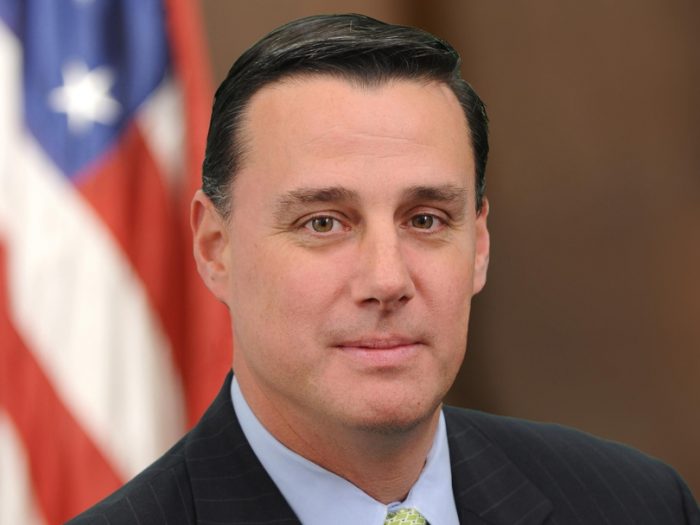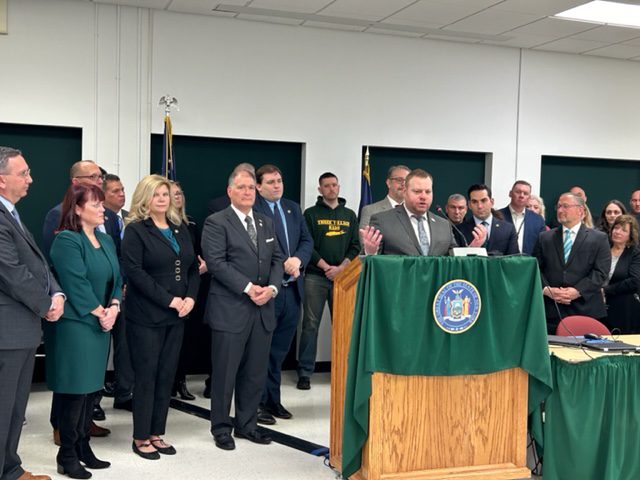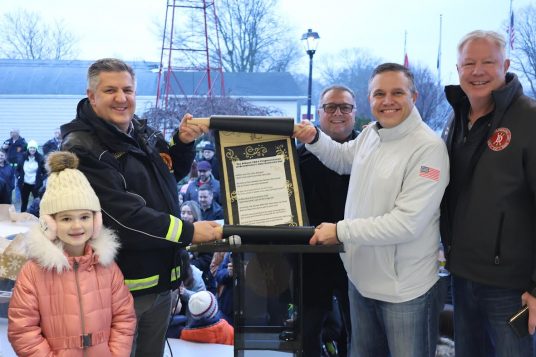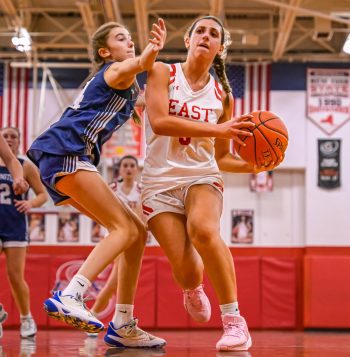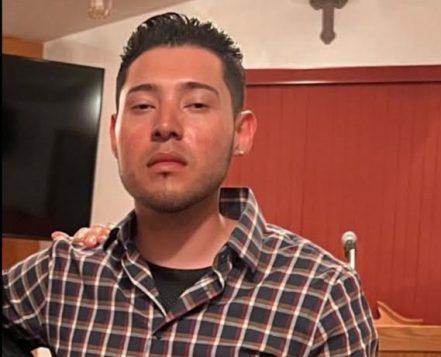Hooray for Theatre Three
As a longtime season ticket holder of Port Jefferson’s Theatre Three, I certainly appreciate the fine job Bradlee and Marci Bing did with their performance of “The Gin Game.” They still have it! To all who read this, we are blessed with live theater in our village. It is difficult these days to compete with modern technology, but on the other hand up close and personal performances are something special. This is more than a plug for Theatre Three. It is a message of do not miss these opportunities for live entertainment in your local area
Harry Faulknor
Port Jefferson
Glad for Lawrence Aviation action and looking for more
The The tentative Metropolitan Transportation Authority deal at the former Lawrence Aviation site in Port Jefferson Station is moving forward with positive reactions from the officials on this plan. It is a partnership with federal, state, county and town officials that is making this happen:
Proposed MTA electric line trainyard with a county bridge constructed if New York State requires it.
A passive solar farm that is proposed in the old buildings site, which is being cleared and the metals being recycled.
The much-needed open-forested space in our hamlet as a buffer. All this is still in the planning process with the Suffolk County Landbank Corporation working on the details of which some are time critical such as the federal Environmental Protection Agency lifting the Superfund designation by the end of this year and the New York State Department of Transportation working on any Greenway rerouting.
We in the community are glad for the positive results we see with the removal of these eyesores and are now asking our officials to move on with the paperwork. Our Port Jefferson Station has been looking for years for this progress. Let’s make it happen.
Charlie McAteer
Port Jefferson Station
Legal immigrants justifiably fearful
If true, it is commendable that George Altemose [“Legal talented scientists are welcomed,” Jan.18, TBR News Media] and Paul Mannix [“The illegal immigration issue,” Jan. 25, TBR News Media] harbor no animosity toward legal immigrants, and only object to illegal immigration. Perhaps 40 years ago one could have reasonably argued that most conservatives felt that way. But unfortunately, they are wildly out of touch with the attitudes that now prevail in the Republican Party.
A 2019 Pew poll found 57% of Republican voters fear “losing our identity as a nation” due to immigration, a 13% increase in just two years. That phrasing gives away the game, as equating our “identity” as Americans to ethnicity or race is inherently bigoted. The leading Republican presidential candidate recently said that immigrants are “poisoning the blood of our country.” If they are really a threat to our “blood” it is clearly irrelevant whether they are documented or not. He gleefully separated children from their families and is now promising internment camps and mass deportation for 11 million people peacefully living, working and paying taxes in the U.S. His followers are loving it.
Prospective foreign Cold Spring Harbor Laboratory students and employees rightly recognize that such rhetoric wouldn’t exist if the MAGA faction of the Republican Party was making nuanced distinctions between legal and undocumented immigrants. They understand that this rhetoric, and the normalization of the hatred behind it, pose a real threat to their physical safety.
Let’s be frank: U.S. business loves illegal immigration because it gives a huge pool of vulnerable workers. The farming, meatpacking, construction, landscaping, hospitality, health care and food service industries all heavily exploit cheap, undocumented labor. Republican politicians refuse to effectively punish employers — the only way to actually reduce illegal immigration — because the issue lets them exploi their voters’ racial and ethnic fears in every election. Witness their blocking the recent bipartisan Senate border security bill. MAGA voters, currently driving the Republican Party, are virulently anti-immigrant because they believe the U.S. should be a white, traditional, Christian country.
By all means let’s implement a humane, legal immigration system that actually addresses the obvious workforce needs of the country, punishes illegal hiring, while addressing impacts on infrastructure and services. Let’s pursue a more enlightened foreign policy that helps stabilize and develop Mexico and Central America — by far the largest sources of illegal migration. But let’s not pretend that most Republicans are happy to welcome nonwhite legal immigrants.
John Hover
East Setauket
Wernher von Braun is considered a great American
I would like to respond to a recent commentary letter from Professor Lester G. Paldy regarding my characterization of Wernher von Braun as a great American, as a consequence of his enormous contributions to our space program [“Hardly an example of a great American,” Jan. 25, TBR News Media].
It is true that von Braun was instrumental in the development and use of the German V-2 rocket during World War II. He was forced to join the Nazi party in 1937, when he was 25 years of age, and the SS in 1940, when he was 28. He showed no enthusiasm for activities other than rocket development, and advocated for work on space travel. In 1944, von Braun was suspected of having a defeatist attitude, for which he was arrested by the Gestapo and held for two weeks, before being released because his contributions were deemed essential for the German war effort.
Following the defeat of Germany, von Braun and more than 100 of his associates were brought to the United States, where they were attached to the U.S. Army Ordnance Corps for the purpose of developing advanced military rockets. This effort was enormously successful under von Braun’s leadership. They produced the Redstone and Jupiter-C missiles, leading to our entry into the space program with our first satellite in 1958, closely following the Soviet Union’s Sputnik a year earlier. This was followed by the Saturn V rocket, which took us to the moon in 1969, and is still the most powerful machine ever built by man. None of this would have been possible without von Braun, both for his technical leadership and for his popular promotion of the importance of sending people into space.
Today, von Braun remains a controversial figure, primarily as a result of the brutal use of Holocaust slave labor for the manufacture of the V-2 rockets. Research appears to show that he was aware of this situation, but was powerless to prevent it. Had he tried, he would have been immediately removed from the program, and almost certainly killed. As it turned out, he spent the first 33 years of his life in Germany, and his next — and last — 32 years as a model citizen of the United States. Was he a great American? I believe that he was.
George Altemose
Setauket
Need to reassess Hochul’s plan to decrease our school aid
As a lifelong member of the Three Village community, alumnus of Ward Melville High School and parent of a school-aged child, I am incensed by Gov. Hochul’s [D] plan to decrease our state aid by nearly $9 million.
The recent proposal for the 2024-25 school year to cut nearly 18% of state aid to our district is quite plainly unjustifiable and contradictory to the current “hold harmless” policy. On Jan. 16, during the governor’s budget presentation, she touted “the highest level of education funding in state history,” yet she has chosen to penalize a district that was previously recognized by the State Comptroller’s Office as “susceptible to fiscal stress.”
The decision to drastically cut aid to a high performing Long Island school district has the capacity to catastrophically fracture our incredible academic, arts, music, technology and extracurricular programs. We would also be vulnerable in areas concerning mental health and wellness, and physical safety and security at a time when these services are more essential than ever before.
Politicization of this situation would be a very easy sword to throw ourselves upon, but this is not the time to make this a “red-blue” issue. We need to stand together as it is truly incomprehensible to think that more consideration should not be given to all that would be lost by our district if these cuts were to happen. I, along with many other parents and community members, have reached out to the governor and other state officials in an attempt to urge a reassessment of the proposal.
Our district simply cannot sustain the potential long-lasting damage that this proposed budget could cause, and our kids are worth the strength we can exude in our words and actions.
Time is of the essence. Take a stand for our kids.
Stefanie Werner
East Setauket
Setauket Neighborhood House: a community gem
I recently attended a meeting of the Three Village Chamber of Commerce at the Setauket Neighborhood House and was intrigued on how our community came to own this wonderful place situated across from the lake leading into Frank Melville Park on Main Street.
The plaque in the house says the Neighborhood House was purchased by the 19th-century industrialist Eversley Childs and his wife Minnie and given to the Setauket community as a place for meetings and community gathering since 1918.
What a wonderful philanthropic gesture by the Childs couple to bequeath our community with a publicly-owned meeting house that in many ways is the center of community activity in the Three Villages. I know of few other places on Long Island that have such a community run and supported meeting house.
Kudos to the members of the Setauket Neighborhood House’s board of directors and its manager for providing a special gathering place for civic, community and family events and for keeping it in such historic splendor. And a belated thank you to Eversley and Minnie Childs for their considerable community philanthropy and wisdom in providing a place for the Setauket community to meet and come together for more than 100 years.
George Hoffman
Setauket
Best person to serve as an MTA board member
Suffolk County Executive Ed Romaine [R] now has an opportunity to appoint a representative to the Metropolitan Transportation Authority 15-member board. Allow me to offer my services. I’ve been a regular Long Island Rail Road commuter for decades and previously worked for the Federal Transit Administration Region 2 New York Office. This included the development, review, approval and oversight for billions of dollars in annual grants that supported capital projects and programs for the MTA including the LIRR, NYC Transit subway, bus and Staten Island Railway, Metro-North Rail Road and MTA Bus along with 30 other transit agencies in New York and New Jersey. I also assisted the MTA in winning a number of national competitive discretionary grants.
I possess a detailed knowledge of all MTA operating agencies including the LIRR physical assets such as equipment, stations, yards, shops and maintenance as well as management of capital projects and programs. I gave emphasis to completing federally funded projects on time, within budget with a minimum number and dollar value for contract change orders. They had to be justified as fair and reasonable. This was my motto for the MTA and LIRR.
There is no MTA board member today who has had firsthand experience in applying for and managing federal assistance from Washington. Federal dollars play a key role in the success of MTA’s capital program. My addition to the board could be a real asset. Having no driver’s license, I have always been transit dependent. Being retired, I could represent the interests of Long Island commuters, taxpayers and transit advocates as a full-time member on the MTA board at no expense.
Larry Penner
Great Neck
Tell Hochul to keep the ‘hold harmless’ state school aid provision
I join fellow residents and school districts in shock and dismay after reviewing Gov. Hochul’s [D] proposed cuts to some local districts’ state education aid. There is no way to justify pulling the rug out from under our already strained school districts. This would only lead to hasty discussions about cuts to our children’s programming and staff, and likely increases to our already excessive property taxes.
The proposed education aid reductions to 44% of New York state’s school districts — and increases in aid to the other 56% — result from the governor’s proposal to end the “hold harmless” provision. This provision has historically provided all districts with at least as much state education aid as they received in the previous fiscal year.
Unfortunately, state Assemblyman Ed Flood’s [R-Port Jefferson] claim that “Hochul is dumping taxpayer dollars into New York City’s disastrous migrant crisis and leaving the priorities of New Yorkers behind” is either a misunderstanding of how the NYS budget works or a political attempt to pin our community’s upset on an unrelated issue. In the proposed budget, statewide education aid would actually increase by over 2% to a total of $35.3 billion, and our districts would lose funding only because this aid is being redistributed without the “hold harmless” provision.
Any attempt to tie this nonpartisan education policy issue to any partisan issues will weaken this urgent call to action. For the sake of our children’s quality of education and to avoid another burdensome tax hike, we must join in bipartisan opposition to this sudden abandoning of the “hold harmless” provision in the state’s foundation aid formula. We need all community leaders and residents to wholly engage in a clear message to Hochul: Reinstate the “hold harmless” provision for the 2024-25 state budget.
Rebecca Kassay
Port Jefferson
The writer has declared her candidacy for New York’s District 4 Assembly seat under the Democratic ticket.

